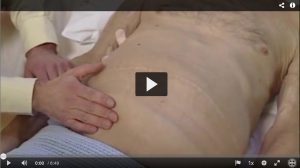 A short introduction to how kidney diseases come to attention, and what to look for. 45 mins.
A short introduction to how kidney diseases come to attention, and what to look for. 45 mins.
Neil Turner, Professor of Nephrology. Part of Renal/Urology in the Edinburgh MBChB.
Familiarity with cardiovascular, respiratory, and GI symptoms and examination assumed here, so what’s new? A few questions, but for examination, there is only a little to revise or add to what you’ve already covered in general examination, plus the cardiovascular system and abdomen. Don’t forget to add urine dipstick results though.
Symptoms
Most kidney diseases create few specific symptoms until late. And often the most prominent signs are through upset fluid balance, which becomes apparent in the general examination and cardiovascular system.
How does renal disease present?
Urinary symptoms are a common reason for GP consultations. UTI is common in infants and the elderly, and at other ages more common in women. Problems with continence are common in children, and in older men (prostate gland enlargement in particular) and women (bladder dysfunction in particular); there are uncommon but important neurological causes too. But for a nephrologist concerned about loss of kidney function altogether, symptoms match severity quite poorly. (8.20 mins. Jump to 5.18 for pain; 6.30 symptoms of renal insufficiency)
How do you spot/ identify renal disease?
When it creeps up over a period, even advanced chronic renal impairment may be virtually asymptomatic. Diseases not causing those symptom clusters are often identified through tests. (10.20 mins)
How to examine
Principles (4 mins). Remember that the kidneys are far back in the abdomen.
Fluid imbalance and other signs
Fluid (= salt and water) overload is common. It can look like heart failure: beware ‘hypertensive heart failure’ – check renal function. (4.59 mins)
Examination video
7 min abbreviated version including highlights from previous antique video are viewable if you have a UoE login.
 (click to view – UoE login required)
(click to view – UoE login required)
Further info
- Haematuria and Proteinuria in the edrep textbook (edrep.org/textbook). (Don’t forget Schistosomiasis). The textbook has pages also on UTI.
- Our website edren.org has detailed info for patients at edren.org/info. These give more than enough info for students about most renal conditions.
- Assessment of JVP (advanced) An important element of clinical examination, but difficult to learn. Practice everywhere, including in your renal attachment, as you’ll see JVPs at all levels there.
And also
| Peter Lundin (1944-2001), physician-patient role model
His account of the symptoms of uraemia, evidenced by his experience of too little dialysis, is included in some of the clips above.
|



0 Comments